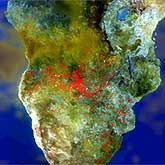What Are Aerosols?
 Aerosols are tiny particles suspended in the air. Most occur naturally, originating from volcanoes, dust storms, forest and grassland fires, living vegetation, and sea spray (Figure 1). Human activities, such as the burning of fossil fuels and the alteration of natural surface cover, also generate aerosols. Averaged over the globe, aerosols made by human activities currently account for about 10 percent of the total amount of aerosols in our atmosphere. Most of that 10 percent is concentrated in the Northern Hemisphere, especially downwind of industrial sites, slash-and-burn agricultural regions, and overgrazed grasslands.
Aerosols are tiny particles suspended in the air. Most occur naturally, originating from volcanoes, dust storms, forest and grassland fires, living vegetation, and sea spray (Figure 1). Human activities, such as the burning of fossil fuels and the alteration of natural surface cover, also generate aerosols. Averaged over the globe, aerosols made by human activities currently account for about 10 percent of the total amount of aerosols in our atmosphere. Most of that 10 percent is concentrated in the Northern Hemisphere, especially downwind of industrial sites, slash-and-burn agricultural regions, and overgrazed grasslands.
Scientists have much to learn about the way aerosols affect regional and global climate. We have yet to accurately quantify the impacts of natural aerosols on climate, relative to impacts of aerosols made by humans. Moreover, we do not know whether the total amount of atmospheric aerosol is roughly constant, is diminishing, or is increasing. Overall, we do not even know whether aerosols are warming or cooling our planet.
During the last 30 years, scientists have identified several major aerosol types and they have developed general ideas about the amount of aerosol to be found in different seasons and locations. Still, key details about the amount and properties of aerosols are needed to calculate even their current effect on surface temperatures and so far it has not been possible to make these measurements on a global scale.
About the Author
NASA Goddard Space Flight Center
 The Goddard Space Flight Center is a major NASA space research laboratory located approximately 6.5 miles northeast of Washington, D.C. in Greenbelt, Maryland, United States.
The Goddard Space Flight Center is a major NASA space research laboratory located approximately 6.5 miles northeast of Washington, D.C. in Greenbelt, Maryland, United States.


